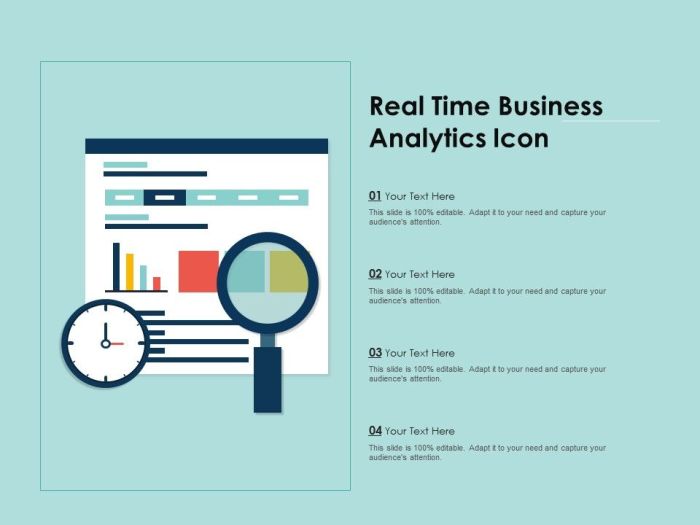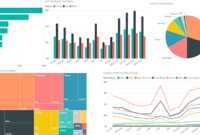Real-time business analytics revolutionizes decision-making by providing instant insights into data trends, enabling businesses to stay ahead of the curve in a fast-paced market environment. In this comprehensive guide, we delve into the intricacies of real-time analytics and explore its impact on modern business operations.
From defining real-time business analytics to discussing implementation strategies and showcasing real-world applications, this guide offers a deep dive into the transformative power of leveraging data in real-time for strategic decision-making.
Overview of Real-time Business Analytics
![]()
Real-time business analytics refer to the process of using data and technology to analyze and present information about business operations as they occur. This allows companies to make informed decisions quickly based on up-to-the-minute data.
Importance of Real-time Data in Decision-making
Real-time data is crucial for decision-making as it provides accurate and current information about the business environment. With the constantly changing market dynamics, having access to real-time data helps organizations adapt swiftly to market trends, customer behaviors, and competitive activities.
- Real-time data allows businesses to respond promptly to opportunities and threats in the market.
- It enables companies to optimize their operations in real-time, leading to improved efficiency and productivity.
- Having access to up-to-date data helps in reducing risks and making more informed decisions, contributing to overall business success.
Benefits of Using Real-time Analytics for Businesses
Real-time analytics offer numerous advantages to businesses, enhancing their decision-making processes and overall performance.
- Improved agility: Real-time data enables businesses to react quickly to changing market conditions, giving them a competitive edge.
- Enhanced customer experience: By analyzing real-time data, companies can personalize their interactions with customers, leading to higher satisfaction and loyalty.
- Cost savings: Real-time analytics help in identifying inefficiencies and optimizing processes, leading to cost savings in the long run.
Tools and Technologies for Real-time Business Analytics
Real-time business analytics rely on a variety of tools and technologies to enable organizations to make data-driven decisions quickly and efficiently. Let’s explore some of the popular software tools used for real-time business analytics and compare different technologies like data streaming, in-memory computing, and machine learning in the context of real-time analytics.
Popular Software Tools for Real-time Business Analytics
- Tableau: Tableau is a powerful data visualization tool that allows businesses to create interactive and shareable dashboards for real-time analysis.
- Power BI: Microsoft’s Power BI is another popular choice for real-time analytics, offering robust reporting and visualization capabilities.
- Splunk: Splunk specializes in machine data analytics, providing real-time insights into IT infrastructure and operational data.
Comparison of Technologies in Real-time Business Analytics
- Data Streaming: Technologies like Apache Kafka and Amazon Kinesis enable real-time data streaming, allowing businesses to process and analyze data as it is generated.
- In-Memory Computing: In-memory databases like SAP HANA and Oracle TimesTen store data in memory for faster processing, ideal for real-time analytics applications.
- Machine Learning: Machine learning algorithms can be integrated into real-time analytics platforms to uncover patterns and insights in streaming data, enhancing decision-making capabilities.
Leveraging Tools for Competitive Advantage
- Businesses can leverage real-time analytics tools to gain a competitive edge by responding swiftly to market trends, optimizing operations, and personalizing customer experiences.
- By harnessing the power of data streaming, in-memory computing, and machine learning, organizations can make proactive decisions based on real-time insights, positioning themselves ahead of the competition.
Implementation Strategies for Real-time Business Analytics

Implementing real-time business analytics is crucial for organizations looking to make data-driven decisions quickly. Below are some best practices, challenges, and successful examples to consider when implementing real-time analytics in a business setting.
Best Practices for Implementing Real-time Analytics, Real-time business analytics
- Define clear objectives: Clearly Artikel the goals and objectives you aim to achieve with real-time analytics.
- Invest in the right technology: Choose appropriate tools and technologies that suit your business needs and can handle real-time data processing.
- Ensure data quality: Maintain high data quality standards to avoid inaccuracies in real-time insights.
- Train employees: Provide adequate training to employees on how to use real-time analytics tools effectively.
- Establish a data governance framework: Implement proper governance policies to ensure data security and compliance.
Challenges and How to Overcome Them
- Data integration issues: Address data silos and ensure seamless integration of data from various sources.
- Scalability concerns: Plan for scalability in advance to accommodate increasing data volumes and user demands.
- Real-time processing complexity: Simplify complex data processing workflows to enable real-time analytics efficiently.
- Change management: Encourage a culture of data-driven decision-making to overcome resistance to adopting real-time analytics.
Successful Real-time Analytics Implementations in Different Industries
- Retail: Implementing real-time inventory management systems to optimize stock levels and improve customer satisfaction.
- Finance: Using real-time fraud detection algorithms to identify and prevent fraudulent transactions in banking operations.
- Healthcare: Leveraging real-time patient monitoring systems to improve patient care and treatment outcomes in hospitals.
Use Cases and Applications of Real-time Business Analytics

Real-time business analytics have revolutionized the way companies make decisions and interact with their customers. By leveraging real-time data insights, organizations can gain a competitive edge and drive growth. Let’s explore some key use cases and applications of real-time business analytics.
Enhancing Customer Experience
Real-time business analytics enable companies to provide personalized and targeted customer experiences. For example, e-commerce giant Amazon uses real-time analytics to recommend products based on customers’ browsing history and purchase behavior. This not only enhances customer satisfaction but also increases sales and customer loyalty.
- Real-time customer segmentation: Companies can segment their customers in real-time based on behavior, preferences, and demographics to deliver customized marketing messages and offers.
- Dynamic pricing: Retailers can adjust prices in real-time based on demand, competitor pricing, and other market factors to maximize revenue and profit margins.
- Proactive customer service: By analyzing real-time data from various touchpoints, companies can identify and address customer issues before they escalate, improving customer satisfaction and loyalty.
Optimizing Operational Efficiency
Real-time business analytics also play a crucial role in optimizing operational efficiency across various industries. For instance, manufacturing companies use real-time analytics to monitor equipment performance, predict maintenance needs, and streamline production processes.
- Supply chain optimization: Real-time analytics help companies track inventory levels, monitor supplier performance, and identify potential bottlenecks in the supply chain to ensure smooth operations.
- Predictive maintenance: By analyzing real-time data from sensors and IoT devices, companies can predict when equipment is likely to fail and schedule maintenance proactively, minimizing downtime and reducing costs.
- Workforce management: Real-time analytics enable companies to optimize workforce scheduling, allocate resources efficiently, and identify training needs to enhance productivity and reduce labor costs.
Driving Revenue Growth
Real-time business analytics have a direct impact on revenue growth by enabling companies to make data-driven decisions quickly and accurately. By analyzing real-time sales data, market trends, and customer behavior, organizations can identify new opportunities, optimize pricing strategies, and launch targeted marketing campaigns.
Real-time analytics empower companies to seize opportunities, mitigate risks, and stay ahead of the competition in today’s fast-paced business environment.
- Cross-selling and upselling: Real-time analytics help companies identify cross-selling and upselling opportunities based on customer behavior and purchase history, leading to increased revenue and customer lifetime value.
- Campaign performance optimization: By monitoring the performance of marketing campaigns in real-time, companies can quickly adjust strategies, allocate budgets effectively, and maximize ROI.
- Revenue forecasting: Real-time analytics enable companies to forecast revenue more accurately, identify revenue drivers, and make informed decisions to achieve revenue targets.
As businesses continue to embrace the era of real-time data analytics, the possibilities for growth and innovation are endless. By adopting cutting-edge tools and technologies, companies can unlock new opportunities, optimize efficiency, and drive revenue growth in today’s dynamic marketplace. Stay ahead of the competition with real-time business analytics and pave the way for a successful future.
When it comes to handling large sets of data, having the right Big Data visualization tools is crucial. These tools allow businesses to analyze and interpret complex data sets effectively, leading to better decision-making processes.
For companies looking to streamline their operations and improve efficiency, utilizing BI automation tools is a game-changer. These tools automate repetitive tasks and processes, freeing up time for employees to focus on more strategic initiatives.
Implementing the right BI solutions for companies can significantly enhance decision-making processes and drive business growth. These solutions provide valuable insights and analytics that enable organizations to make informed choices and stay ahead of the competition.




